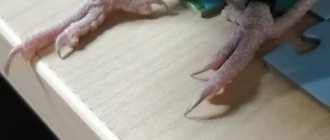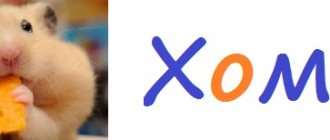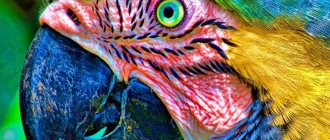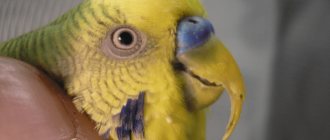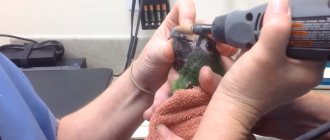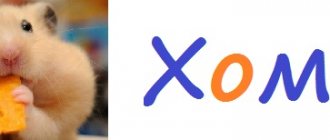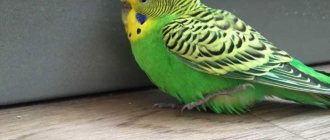Wavys are cute domestic birds that need constant care from the owner. The health, mood and life expectancy of the pet depend on the correctness of this process.
Therefore, sometimes you even have to trim the bird’s beak. It is important to understand the nuances of how to trim a budgie’s beak correctly and not harm your pet. Additionally, it is necessary to use certain preventive measures aimed at preventing the growth of the stratum corneum.
Beak structure
A parrot's beak consists of the following elements:
- the beak, formed by the jaw, premaxillary and nasal bones;
- the mandible, formed by many small bones;
- tendon ligament;
- cere with nostrils.
The tendon ligament attaches the bones of the mandible and mandible to the bones of the skull. Due to the fact that the beak does not fuse with the skull, it remains mobile. On top, the bone base is covered with a stratum corneum, which is constantly growing. The parrot actively uses its beak, so its edges quickly wear out. A new one grows to replace the worn out stratum corneum. Normally, the horny cover of the upper beak is completely replaced in six months, the lower beak - a little faster. In a healthy parrot, the beak always retains its shape: the mandible and mandible fit tightly to each other, their edges are sharp, the horny cover is shiny, not flaking, without cracks.
Parasites
There are cases when growths appear on the beak due to the presence of parasites on the bird. If observed:
- nose enlargement;
- growths similar to papillomas around the eyes, on the wax, paws,
then these are symptoms that parasitic microorganisms have settled on the pet. To get rid of them, you need to treat areas with growths with aversectin or novertin ointments.
Why trim the beak?
The beak is an extremely important organ for birds. With its help, the parrot performs many actions:
- captures, splits, crushes and grinds food;
- cleans feathers;
- gets rid of parasites;
- senses the temperature and shape of objects;
- grabs and carries objects;
- climbs trees and cage bars;
- builds a nest;
- feeds the chicks;
- protects itself from predators and rivals;
- communicates with relatives and humans.
If a parrot has grown a long beak, it will prevent the bird from performing all vital actions. The parrot will not be able to eat normally, its physical activity will decrease, and the condition of its plumage will worsen. Ultimately, this will lead to illness, and in advanced cases, death. In addition, with an overgrown beak, a bird can injure itself when performing hygiene procedures. To prevent this from happening, the beak must be trimmed in a timely manner.
Is nail trimming painful for parrots?
It does not harm the bird if you pinch your nails. This can be compared to cutting human hair or cutting nails. But please note: this does not harm the bird as long as you hold the bird correctly. Don't squeeze her or her paws. If you cannot do this, contact your veterinarian and ask for help. Or let your avian veterinarian show you how to trim your budgie's nails yourself.
Mites on a parrot's beak
Budgerigars whose beaks are infested with mites often suffer from severe beak malformations. Sometimes it grows too long and in some cases the wrong shape. You may want to help, but it is very dangerous to trim a beak that has structural damage caused by mites.
Why does a parrot grow a beak?
Excessive beak growth is a common problem when keeping budgies in captivity. It may be due to the following reasons:
- Insufficient stitching. In nature, parrots constantly use their beaks, as a result of which the stratum corneum wears off quickly and evenly. In captivity, the physical activity of birds is limited; they have little contact with hard and rough objects, so the wear off of the stratum corneum occurs more slowly; the rate of its growth remains the same, as a result of which the length of the beak increases.
- Parasitic infestations and fungal infections. Some parasites (scabies mites) infect the beak and limbs of birds, causing the formation of horny growths. Pathogenic fungi can penetrate microcracks in the stratum corneum, which leads to the destruction of the horn.
- Feeding disorders: deficiency or excess of vitamins and minerals in the diet, feeding too fatty foods, feeding predominantly soft foods and lack of solid foods in the diet.
- Internal diseases: liver diseases, metabolic disorders, congenital diseases.
- Injuries. After injury to the beak, its growth is often disrupted. The shape changes, and a horny substance grows at the site of injury.
- Hormonal disbalance. This problem is most often observed in males older than 5-7 years.
Main reasons for growth
Wild birds in nature are not limited in their movements. They move freely: they run a lot, climb trunks, cling to branches. Such vigorous activity has a good effect on the condition of the claws and beak, which wear down naturally. At home, budgies stay inside a cage for days, and many of the pleasures of their free relatives are not available to them. Inexperienced breeders sometimes cannot understand why a parrot's beak grows quickly. And this comes precisely from an imposing lifestyle and cramped conditions.
It’s good if the owner does not forget about fresh twigs and sepia, which the pet needs so much. If the cage only has a wooden perch, your budgie may try to sharpen its beak by rubbing it against the perch or bars. This load is not enough to control the length of the beak: it begins to grow, bends and breaks off.
The main factors influencing the rapid growth of the stratum corneum:
- consumption of feed with mineral supplements;
- enhanced vitamin supplementation;
- metabolic disorder;
- liver problems;
- hormonal disbalance;
- congenital disease;
- malocclusion due to injury.
The bird can be cautious and take care when it feels painful. The fragile, brittle cornea grows and becomes deformed when it is infested with mites.
If you notice that the parrot is experiencing discomfort, help it - shorten its beak, otherwise the bird will not be able to eat properly. There is nothing wrong with cutting your hair, but you should be well prepared for this event to avoid unpleasant consequences.
How to trim a parrot's beak
The beak trimming procedure must be carried out carefully so as not to harm the bird. For the first time, it is better to perform the manipulations with an assistant: one person will fix the parrot, the other will trim the beak. In the future, after gaining experience, this procedure will be easy to carry out alone.
Necessary equipment
To trim a parrot's beak, you will need:
- a special veterinary instrument for beak trimming, sharpened nail scissors or tweezers;
- cotton wool;
- medical alcohol;
- hydrogen peroxide;
- potassium permanganate solution.
There are blood vessels inside the parrot's beak. When cutting the horny substance, it is important not to damage them. To determine where the living tissue ends and the dead horn begins, the beak is examined from the side with a flashlight. In transmitted light, the boundary will be clearly visible. Only the part that does not contain vessels is cut off.
Beak trimming procedure
All instruments are pre-disinfected with alcohol. Manipulations are carried out in a well-lit place. The parrot is fixed in the hand, placing its back on the palm. In this case, its wings should be pressed to the body, and its head should be between the thumb and forefinger. The bird is held gently without squeezing it too tightly.
The beak is viewed in transmitted light and the boundary between living and dead tissue is determined. It can be carefully marked on the surface of the stratum corneum with a pencil. The regrown stratum corneum is cut off gradually, in small parts. In this way, the beak of a budgie is trimmed until it takes on its natural shape. After completing the procedure, the edges of the beak are treated with a solution of potassium permanganate for the purpose of disinfection.
The bird is placed back into the cage. Clean water is poured into the drinking bowl, and the food is removed for several hours. This is necessary so that microbes and dirt do not get into the wounds and microcracks that could form during pruning. Used instruments are treated with alcohol.
Video material
The beak trimming procedure may seem complicated to someone who has never done it before. This video clearly shows how to properly trim a budgerigar's beak. Strictly following the instructions will help you perform the manipulations properly and not harm your pet.
Possible problems
You should not cut off the horny substance in large parts - this may cause it to burst, and a crack will appear on the beak, into which pathogenic microorganisms can penetrate. It is also not allowed to use rough tools (for example, large tongs or wire cutters) to avoid cutting off excess. If during the pruning process living tissue was touched and bleeding began, it is necessary to apply a piece of cotton wool moistened with hydrogen peroxide to the wound. After this, the bleeding will quickly stop.
Possible problems
Difficulties may arise when cutting off excess parts:
- you cannot cut off too much of a part, as this can lead to the appearance of significant cracks, and the beak may burst, so harmful bacteria can easily penetrate into the crack;
- if you use rough instruments, such as nippers or forceps, as this often leads to excessive cutting of the stratum corneum, so the bird will bleed;
- if living tissue is touched and blood appears, then it is necessary to pour hydrogen peroxide onto a cotton swab, which is then applied to the wound.
If the procedure is performed by a beginner, then it is advisable to cut off the beak in small parts. Although the process takes a lot of time, it helps to obtain the desired result.
Prevention of beak growth
To prevent your parrot from having to trim its beak too often, you should prevent its excessive regrowth. To do this, increase the number of objects in the cage on which the bird can grind its beak. Plastic toys and perches are replaced with wooden ones. The parrot is regularly allowed to chew on branches of fruit trees, as well as sepia or mineral stone. The proportion of solid feed – grains and seeds – is increased in the diet. Vitamin supplements are administered periodically, without exceeding the dosage indicated on the package.
When walking, make sure that the parrot does not get injured. Particular attention should be paid to curtains of windows and mirrors. If mites are the cause of the formation of horny growths, the affected areas are treated with aversectin ointment. The cage is kept clean, preventing the proliferation of parasites and the development of fungal infections.
Results
The problem of long cere in parrots must be dealt with, otherwise it can end in disaster. We figured out why the cere grows in a parrot.
This is due to:
- hormonal imbalance;
- improper nutrition and, as a result, lack of vitamins and nutrients in the bird’s body;
- due to the lack of grinding objects in the cage (chalk, stone, branches, etc.);
- due to damage to the cere by parasites.
Having noticed and determined the cause of the problem of beak growth in parrots, the owner must immediately take action. In any case, it would be a good idea to consult a veterinarian for advice.
Changes in behavior
Unfortunately, such diseases begin unnoticed, initially having virtually no effect on the life of budgerigars. Sometimes owners notice that something is wrong with their pet only when growths are already visible on its body.
In order to notice possible problems in the bird’s body in time, owners need to not only properly care for their parrots and maintain them properly, but also periodically pay attention to them. In addition to playing and walking around the apartment, you need to monitor the movements of the birds and inspect them at least once a week.
Often, changes in its behavior help to detect that a budgie is sick. A sick pet becomes lethargic or, conversely, too restless. He stops chirping contentedly, and sometimes even falls silent for a long time.
He may often sleep at times when he should be awake. It is worth noting the fact that healthy birds usually sleep on one leg, while sick individuals sleep on two. In this position, it is easier for them to stay on the perch, because they spend all their strength on fighting the disease.
A conscientious owner of a feathered pet should become concerned if he notices at least one of the signs listed above and begin treatment. An advanced disease usually leads to death.
